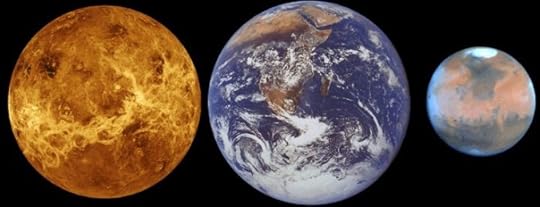Elizabeth Tasker's Blog, page 3
November 29, 2018
Does Proxima Centauri Create an Environment Too Horrifying for Life?

Artist’s impression of the exoplanet Proxima Centauri b. (ESO/M. Kornmesser)
In 2016, the La Silla Observatory in Chile spotted evidence of possibly the most eagerly anticipated exoplanet in the Galaxy. It was a world orbiting the nearest star to the sun, Proxima Centauri, making this our closest possible exoplanet neighbour. Moreover, the planet might even be rocky and temperate.
Proxima Centauri b had been discovered by discerning a periodic wobble in the motion of the star. This revealed...
October 24, 2018
What Would Happen If Mars And Venus Swapped Places?
Venus, Earth and Mars (ESA).
What would happen if you switched the orbits of Mars and Venus? Would our solar system have more habitable worlds?
It was a question raised at the “Comparative Climatology of Terrestrial Planets III”; a meeting held in Houston at the end of August. It brought together scientists from disciplines that included astronomers, climate science, geophysics and biology to build a picture of what affects the environment on rocky worlds in our solar system and far beyond....
October 18, 2018
Prepare For Lift-off! BepiColombo Launches For Mercury
Artist illustration of the BepiColombo orbiters, MIO and Bepi, around Mercury (JAXA).
This Friday (October 19) at 10:45pm local time in French Guinea, a spacecraft is set to launch for Mercury. This is the BepiColombo mission which will begin its seven year journey to our solar system’s innermost planet. Surprisingly, the science goals for investigating this boiling hot world are intimately linked to habitability.
Mercury orbits the sun at an average distance of 35 million miles (57 million k...
June 28, 2018
Asteroid Remains Around Dead Stars Reveal the Likely Fate of Our Solar System
Artist concept of an asteroid breaking up. (NASA/JPL-Caltech)
June 30th has been designated “Asteroid Day” to promote awareness of these small members of our solar system. But while asteroids are often discussed in the context of the risk they might pose to the Earth, their chewed up remains around other stars may also reveal the fate of our solar system.
It is 6.5 billion years into our future. The sun has fused hydrogen into a core of heavier helium. Compressed by its own gravity, the heliu...
May 17, 2018
Know Thy Star, Know Thy Planet: How Gaia is Helping Nail Down Planet Sizes
Gaia’s all-sky view of our Milky Way and neighboring galaxies. (ESA/Gaia/DPAC)
Last month, the European Space Agency’s Gaia mission released the most accurate catalogue to date of positions and motions for a staggering 1.3 billion stars.
Let’s do a few comparisons so we can be suitably amazed. The total number of stars you can see without a telescope is less than 10,000. This includes visible stars in both the northern and southern hemispheres, so looking up on a very dark night will allow y...
April 18, 2018
NASA’s Planet-Hunter TESS Has Just Been Launched to Check Out the Near Exoplanet Neighborhood
[image error]
A SpaceX Falcon 9 rocket transporting the TESS satellite lifts off from launch complex 40 at the Cape Canaveral Air Force Station in Cape Canaveral, Fla., Wednesday, April 18, 2018. The space telescope will survey almost the entire sky, staring at the brightest, closest stars in an effort to find any planets that might be encircling them. (AP Photo/John Raoux)
On January 5, 2010, NASA issued landmark press release : the Kepler Space Telescope had discovered its first five new extra-solar pl...
March 29, 2018
The Just-Approved European ARIEL Mission Will Be First Dedicated to Probing Exoplanet Atmospheres
[image error]
The Ariel space telescope will explore the atmospheres of exoplanets. (Artist impression, ESA)
The European Space Agency (ESA) has approved the ARIEL space mission—the world’s first dedicated exoplanet atmosphere sniffer— to fly in 2028.
ARIEL stands for the “Atmospheric Remote-sensing Infrared Exoplanet Large-Survey mission.” It is a space telescope that can detect which atoms and molecules are present in the atmosphere of an exoplanet.
The mission was selected as a medium class mission in...
February 8, 2018
To Understand Habitability, We Need to Return to Venus
This image shows the night side of Venus in thermal infrared. It is a false-color image using data from the Japanese spacecraft Akatsuki’s IR2 camera in two wavelengths, 1.74 and 2.26 microns. Darker regions denote thicker clouds, but changes in color can also denote differences in cloud particle size or composition from place to place. JAXA / ISAS / DARTS / Damia Bouic
“You can feel what it’s like on Venus here on Earth,” said Kevin McGouldrick from the Laboratory for Atmospheric and Space...






